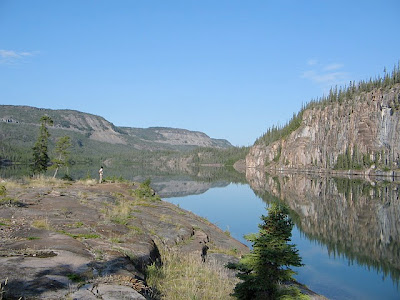Kenora Moose
By: Sarah
When we were growing up in rural Ohio, our family vacation each year (except the year we went to Alaska and the year we visited cousins in California) was a week of fishing in the northwest corner of Ontario with two other families. Every winter the three dads would pore over the terrain maps figuring out where the next trip would be. They would then consult with George Slobodjan, a meat hunter for the gold mines during World War II turned owner of the fishing camp known as Howey Bay Camp in Red Lake, Ontario. They would determine if George had boats for us to take into the wilderness or if we would be able to rent boats from First Nation people in the area. George would also supply the local knowledge of the proposed destination.
Every July, right after wheat harvest, the three families would head north. I have lots of stories of the giant goose in Wawa, the giant moose in Kenora, the locks in Sault Ste. Marie, waking up from an early morning start in time to see the oasis on the toll highway in Chicago, the bridge in Mackinac, counting freighters in Duluth, going through customs in International Falls, the secret pie stops in later years, but those details could fill an entire blog. Almost 50 years later, whenever I see any of the familiar landmarks along any of our travel routes, I'm filled with the same excitement I felt as a child. (Collection of Canadian roadside attractions here.)
The Wawa Goose
We would arrive at the sea plane dock in Red Lake at the appointed time with boxes of groceries bought at the Red Lake grocery store, fishing licenses, boat motors, tackle boxes, canvas cabin tents, pup tents to store the food once we were in camp, sleeping bags, gas stoves, aluminum cook kits, cast iron skillets, camp tables and chairs, and old army duffel bags filled with clothes, life jackets, rubber boots, and all the other paraphernalia required to support three families with small children for a week in the wilderness in a manner that our mother's thought was appropriate.
Red Lake Norseman Bush Plane Monument
The fly-in would take most of the day. Planes with names like Twin Beech, Beaver, and Flying Norseman transported us into a world few others have experienced. By night fall our first catch of the week would be on the supper table and the big cabin tents and sleeping bags were ready for us to crawl into. Usually, someone would have already waded in over their boot tops and the ever familiar rules of “don't go near the water without your life jacket on,” and “don't go into the woods” would have already been repeated dozens of times.
Oh, the adventures that would ensue. Days spent watching moose, catching fish, playing on beaches, eating fresh caught fish on a rocky point, endless mosquito bites, and an occasional bear sighting. Sometimes, we would portage into back lakes or around rapids and waterfalls to see what else there was to see. One time we even portaged 16 miles down a river to reach a Hudson Bay Outpost. One thing we never saw, unless we were close to a First Nation outpost, was other humans. It was easy to believe we were among the first white people to visit many of the lakes where we fished and certainly we were the first children “out there.”
In later years, Dad and I would go up on our own. But things kept changing. Red Lake got paved roads and cable TV, roads were built in to some of the lakes where we could only fly to previously, the canvas on frame freighter canoes were replaced with aluminum V hulls and converted into coffee tables and conversation pieces, and more people and more civilization continued to crowd “our wilderness”. Sometimes we would talk about going to Great Slave Lake, where we heard it was still wild and the fish would still jump into the boat on their own. We’d talk about the stories we’d heard about the lake: how it was known for trophy lake trout and vicious storms that would leave fisherman stranded in camp for days at a time. It was never a practical idea as neither of us had the time or money to make the trek. But it was always in the back of our minds.
Sarah’s Alter Ego on the Great Slave Lake
Flash forward to 2010. When Tom mentioned the idea of Great Slave Lake in 2011, it was only natural for me to say “of course.” The planning is the same, the logistics are the same, the gear is now small enough to fit in a kayak, and the excitement is just as real as it has always been when the outdoors is the destination. Oh, the amphibious plane that will transport us from Yellowknife to the end of the world is called "Otter," and will certainly bring back memories of my childhood flights from Red Lake.






















